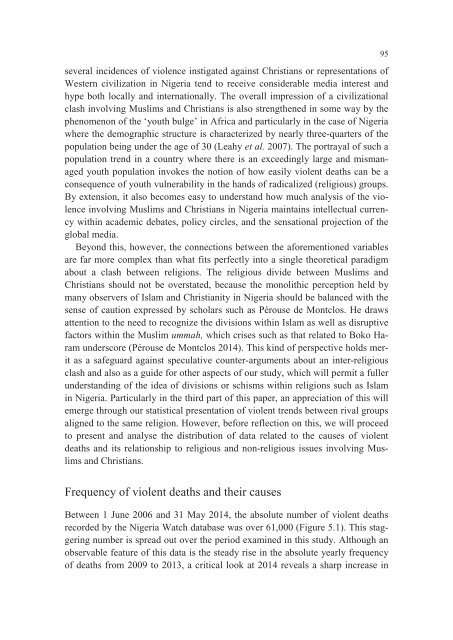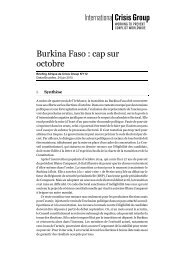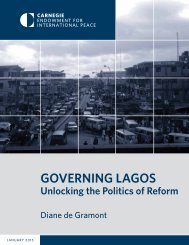Violence in Nigeria
ASC-075287668-3743-01
ASC-075287668-3743-01
You also want an ePaper? Increase the reach of your titles
YUMPU automatically turns print PDFs into web optimized ePapers that Google loves.
several <strong>in</strong>cidences of violence <strong>in</strong>stigated aga<strong>in</strong>st Christians or representations of<br />
Western civilization <strong>in</strong> <strong>Nigeria</strong> tend to receive considerable media <strong>in</strong>terest and<br />
hype both locally and <strong>in</strong>ternationally. The overall impression of a civilizational<br />
clash <strong>in</strong>volv<strong>in</strong>g Muslims and Christians is also strengthened <strong>in</strong> some way by the<br />
phenomenon of the ‘youth bulge’ <strong>in</strong> Africa and particularly <strong>in</strong> the case of <strong>Nigeria</strong><br />
where the demographic structure is characterized by nearly three-quarters of the<br />
population be<strong>in</strong>g under the age of 30 (Leahy et al. 2007). The portrayal of such a<br />
population trend <strong>in</strong> a country where there is an exceed<strong>in</strong>gly large and mismanaged<br />
youth population <strong>in</strong>vokes the notion of how easily violent deaths can be a<br />
consequence of youth vulnerability <strong>in</strong> the hands of radicalized (religious) groups.<br />
By extension, it also becomes easy to understand how much analysis of the violence<br />
<strong>in</strong>volv<strong>in</strong>g Muslims and Christians <strong>in</strong> <strong>Nigeria</strong> ma<strong>in</strong>ta<strong>in</strong>s <strong>in</strong>tellectual currency<br />
with<strong>in</strong> academic debates, policy circles, and the sensational projection of the<br />
global media.<br />
Beyond this, however, the connections between the aforementioned variables<br />
are far more complex than what fits perfectly <strong>in</strong>to a s<strong>in</strong>gle theoretical paradigm<br />
about a clash between religions. The religious divide between Muslims and<br />
Christians should not be overstated, because the monolithic perception held by<br />
many observers of Islam and Christianity <strong>in</strong> <strong>Nigeria</strong> should be balanced with the<br />
sense of caution expressed by scholars such as Pérouse de Montclos. He draws<br />
attention to the need to recognize the divisions with<strong>in</strong> Islam as well as disruptive<br />
factors with<strong>in</strong> the Muslim ummah, which crises such as that related to Boko Haram<br />
underscore (Pérouse de Montclos 2014). This k<strong>in</strong>d of perspective holds merit<br />
as a safeguard aga<strong>in</strong>st speculative counter-arguments about an <strong>in</strong>ter-religious<br />
clash and also as a guide for other aspects of our study, which will permit a fuller<br />
understand<strong>in</strong>g of the idea of divisions or schisms with<strong>in</strong> religions such as Islam<br />
<strong>in</strong> <strong>Nigeria</strong>. Particularly <strong>in</strong> the third part of this paper, an appreciation of this will<br />
emerge through our statistical presentation of violent trends between rival groups<br />
aligned to the same religion. However, before reflection on this, we will proceed<br />
to present and analyse the distribution of data related to the causes of violent<br />
deaths and its relationship to religious and non-religious issues <strong>in</strong>volv<strong>in</strong>g Muslims<br />
and Christians.<br />
95<br />
Frequency of violent deaths and their causes<br />
Between 1 June 2006 and 31 May 2014, the absolute number of violent deaths<br />
recorded by the <strong>Nigeria</strong> Watch database was over 61,000 (Figure 5.1). This stagger<strong>in</strong>g<br />
number is spread out over the period exam<strong>in</strong>ed <strong>in</strong> this study. Although an<br />
observable feature of this data is the steady rise <strong>in</strong> the absolute yearly frequency<br />
of deaths from 2009 to 2013, a critical look at 2014 reveals a sharp <strong>in</strong>crease <strong>in</strong>






